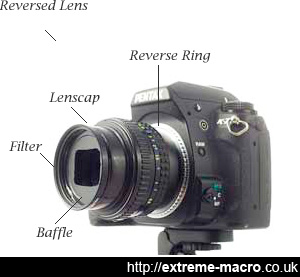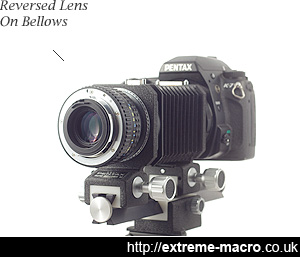Extreme Macro Reversed Lenses
by Johan J Ingles-Le Nobel
Last updated August 31, 2017
Using a lens the wrong way round might seem odd, but it is a cheap way to learn extreme macro photography without buying a macro lens at all.
you need a reverse lens adapterIn fact, when you stop and think about it, reversing lenses makes perfect sense. Because instead of using a lens as a mechanism to look at and transfer the (large area) view through the viewfinder to the (small area) sensor, you are looking at and transferring a (small area) view onto a sensor. Which is what you want in macro.

Pentax K-7 with a reversed 50mm lens. Note the lens hood made out of a lenscap, with deglassed 49mm filter glued on using araldite (to be able to add a filter), and the reversing ring which connects the lens to the camera. Most extreme macro people, myself included, start their extreme macro photography this way.
There are two styles of reversing lenses: a straightforward reversed lens (the only lens used), or a lens reversed onto another lens.
To reverse a lens on its own you need a reverse lens adapter, also known as reverse ring or reversing ring, but to reverse one lens onto another you need a coupling ring, also known as a lens coupling ring or coupling adapter.
Aperture Control
The most challenging aspect of using reversed lenses is the lack of aperture control.
In other words, if you want to use the reversed lens at f/8, you cannot set it in the camera but you have to use the manual aperture ring to fix the lens at f/8.
The most challenging aspect of using reversed lenses is the lack of aperture controlThis not only means you need to use a lens with a manual aperture ring, which most digital lenses lack, but also means you have to focus through a very dark viewfinder (as it's set to f/8) which is problematic.
Exposure metering may also not function correctly depending on your particular body.

Pentax K-7 with a reversed 50mm lens on bellows. As shown, without the lenscap hood, the internals of the reversed lens are visible, and dust and crud will get in there if you're not careful.
Shown mounted on a set of bellows (Pentax Bellows-M), which is used to focus and to increase magnification, and a 13mm extension tube (to permit portrait orientation).
If your reversed lens does not have a manual aperture ring, you cannot stop down and are forced to work at the maximum aperture of your lens.
There are a couple of gadgets of interest that can lessen the pain in certain cases. Novoflex do a reverse adapter for EOS that enables all control functions.
There is also a Nikon adapter for f series lenses that has a stop down ability that can be found on ebay from time to time.
You Will Need To Buy Adapters!
You can buy reverse lens adapters inexpensively from Amazon or eBay. Also known as 'reversing rings', they attach your reversed lens to your camera.
buy reverse lens adapters inexpensively from Amazon or eBayOne side of your reversing ring screws into the end of your lens like a filter, the other attaches to your camera's lens mount.
Likewise, a coupling ring to use one lens reversed onto another, is easily found on eBay, but do make sure to double check the threads of the lenses that you're trying to couple first.
Reversed Lens Magnification
The more distance you put between the lens and the body, the higher the magnification.
So, for example, extension tubes or bellows are both a simple way to increase this distance, and subsequent magnification. Bellows are therefore especially handy because by altering the bellows you can change the magnification that you obtain, as are extension tubes. But be aware that you'll be operating with much less light, and the effective f/stop might lead to diffraction softening if the aperture becomes much too small.
Related Articles




